India - Desert Specialities of Rajasthan, Western India
Saturday 19th November – Wednesday 30th November 2011
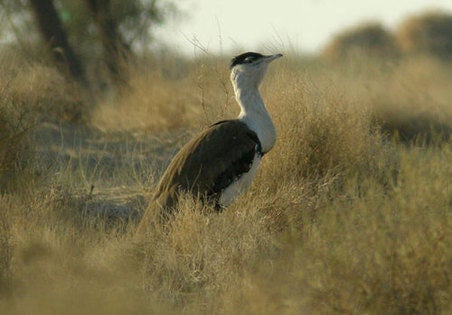 Our new Rajasthan tour takes us on an exciting ride across the vast Thar Desert to witness some of the most spectacular birding on the Indian subcontinent. With scenery more reminiscent of the African savannah and desert scenes that you would expect in the Sahara we will search for some of the region's rarest and most sought-after species. Imagine watching a huge Great Indian Bustard walking sedately across the sandy desert in front of you, or thousands of Demoiselle Cranes feeding just a few metres away, or flocks of sandgrouse uttering their evocative calls as they wheel across a spectacular desert sunset. We target the very special and rarest birds on this tour, including Yellow-eyed Dove, Stoliczka's Bushchat and Green Avadavat, plus a mouth-watering supporting cast of galliformes, coursers, raptors, larks, wheatears, warblers and buntings. This is India as you've never seen it before and as well as the spectacular sand dunes, there is the beautiful town of Jaisalmer to explore, desert camps, beautiful hotels and the overnight train journey which all make for a very exciting Indian adventure.
Our new Rajasthan tour takes us on an exciting ride across the vast Thar Desert to witness some of the most spectacular birding on the Indian subcontinent. With scenery more reminiscent of the African savannah and desert scenes that you would expect in the Sahara we will search for some of the region's rarest and most sought-after species. Imagine watching a huge Great Indian Bustard walking sedately across the sandy desert in front of you, or thousands of Demoiselle Cranes feeding just a few metres away, or flocks of sandgrouse uttering their evocative calls as they wheel across a spectacular desert sunset. We target the very special and rarest birds on this tour, including Yellow-eyed Dove, Stoliczka's Bushchat and Green Avadavat, plus a mouth-watering supporting cast of galliformes, coursers, raptors, larks, wheatears, warblers and buntings. This is India as you've never seen it before and as well as the spectacular sand dunes, there is the beautiful town of Jaisalmer to explore, desert camps, beautiful hotels and the overnight train journey which all make for a very exciting Indian adventure.
|
|
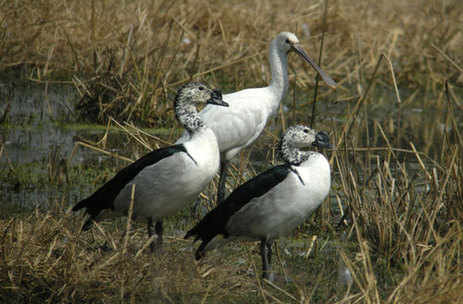 Arrive Delhi and transfer to a hotel for an overnight stay. Depending on flight arrivals, there may be some time to visit Okhla Barrage. This is a remarkable place where birds are numerous and easy to see and there will be quite a few species we probably won't encounter during the rest of the tour and in particular we will search for White-tailed Stonechat. However, most of our attention will be drawn to the open water where huge flocks of familiar wildfowl also host the slightly more exotic Indian Spot-billed Duck and possibly Comb Duck. A flock of Greater Flamingo's are usually present here, along with Garganey, Bar-headed and Greylag Geese, whilst flocks of Brown-headed Gulls and smaller numbers of Steppe Gulls are very conspicuous. Along the water's edge and in the marshes we can find Purple Heron, Glossy and Black-headed Ibis, Indian Peafowl, White-tailed Lapwing, Striated Grassbird, Common Babbler, Pied Bushchat Yellow-bellied and Graceful Prinias, Red Avadavat and Indian Silverbill. Sometimes in the drier areas there is Red-naped (Indian Black) Ibis, as well as Grey Francolin, Spotted Owlet, Yellow-footed Green-pigeon, Red Collared-dove, Purple Sunbird, Hume's Warbler and Siberian Chiffchaff, whilst overhead there will be numerous Black and Black-eared Kites.
Arrive Delhi and transfer to a hotel for an overnight stay. Depending on flight arrivals, there may be some time to visit Okhla Barrage. This is a remarkable place where birds are numerous and easy to see and there will be quite a few species we probably won't encounter during the rest of the tour and in particular we will search for White-tailed Stonechat. However, most of our attention will be drawn to the open water where huge flocks of familiar wildfowl also host the slightly more exotic Indian Spot-billed Duck and possibly Comb Duck. A flock of Greater Flamingo's are usually present here, along with Garganey, Bar-headed and Greylag Geese, whilst flocks of Brown-headed Gulls and smaller numbers of Steppe Gulls are very conspicuous. Along the water's edge and in the marshes we can find Purple Heron, Glossy and Black-headed Ibis, Indian Peafowl, White-tailed Lapwing, Striated Grassbird, Common Babbler, Pied Bushchat Yellow-bellied and Graceful Prinias, Red Avadavat and Indian Silverbill. Sometimes in the drier areas there is Red-naped (Indian Black) Ibis, as well as Grey Francolin, Spotted Owlet, Yellow-footed Green-pigeon, Red Collared-dove, Purple Sunbird, Hume's Warbler and Siberian Chiffchaff, whilst overhead there will be numerous Black and Black-eared Kites. 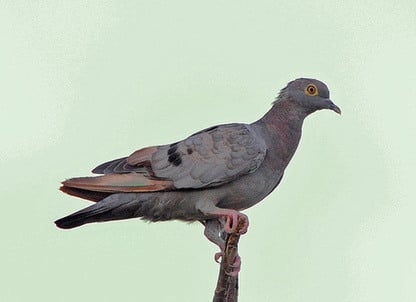 We will make an early start in order to drive to Tal Chhapar Wildlife Sanctuary and should arrive in the afternoon for our first taste of birding in western Rajasthan. Located in the Churu district it was originally managed as a private hunting reserve of the Maharaja of Bikaner, and was declared a Wildlife Sanctuary in 1962. The habitat comprises mainly grassland interspersed with acacias resembling the great plains of the African savannah more than anywhere else in India. Of primary concern to us is the small but regular wintering population of Yellow-eyed Pigeon that travel here from Central Asia and it is a real privilege to see be able to see this endangered and declining species. However, there are many other very good species to find here including Painted Francolin, Chestnut-bellied Sandgrouse, Indian Courser, Sirkeer Malkoha, Sykes's Lark, Red tailed and Variable Wheatears, our first real chance of Stoliczka's Bushchat and Striolated Bunting. There is also a chance of that most elusive of birds, the Spotted Creeper, although a good deal of luck is always needed to find one! Raptors are abundant here, as at most of the sites visited on this tour, and we could see Black-shouldered Kite, Shikra, White-eyed and Long-legged Buzzards, Short-toed Eagle, Steppe, Tawny, Eastern Imperial, Greater and Indian Spotted Eagles, Red- headed, Indian and Eurasian Griffon Vultures, Montagu's Harrier, Red-necked and Laggar Falcons and Eurasian Hobby. There are also many commoner species present such as Indian Thick-knee, Southern Grey Shrike, Rufous-tailed and Crested Larks, Desert and Isabelline Wheatears, Greater Short-toed Lark, Ashy-crowned Sparrow-Lark and White-capped Bunting. There is also a healthy population of the beautiful Blackbuck, and other animals present include Desert and Indian Foxes, Jungle and Desert Cats. Nights at Tal Chhapar.
We will make an early start in order to drive to Tal Chhapar Wildlife Sanctuary and should arrive in the afternoon for our first taste of birding in western Rajasthan. Located in the Churu district it was originally managed as a private hunting reserve of the Maharaja of Bikaner, and was declared a Wildlife Sanctuary in 1962. The habitat comprises mainly grassland interspersed with acacias resembling the great plains of the African savannah more than anywhere else in India. Of primary concern to us is the small but regular wintering population of Yellow-eyed Pigeon that travel here from Central Asia and it is a real privilege to see be able to see this endangered and declining species. However, there are many other very good species to find here including Painted Francolin, Chestnut-bellied Sandgrouse, Indian Courser, Sirkeer Malkoha, Sykes's Lark, Red tailed and Variable Wheatears, our first real chance of Stoliczka's Bushchat and Striolated Bunting. There is also a chance of that most elusive of birds, the Spotted Creeper, although a good deal of luck is always needed to find one! Raptors are abundant here, as at most of the sites visited on this tour, and we could see Black-shouldered Kite, Shikra, White-eyed and Long-legged Buzzards, Short-toed Eagle, Steppe, Tawny, Eastern Imperial, Greater and Indian Spotted Eagles, Red- headed, Indian and Eurasian Griffon Vultures, Montagu's Harrier, Red-necked and Laggar Falcons and Eurasian Hobby. There are also many commoner species present such as Indian Thick-knee, Southern Grey Shrike, Rufous-tailed and Crested Larks, Desert and Isabelline Wheatears, Greater Short-toed Lark, Ashy-crowned Sparrow-Lark and White-capped Bunting. There is also a healthy population of the beautiful Blackbuck, and other animals present include Desert and Indian Foxes, Jungle and Desert Cats. Nights at Tal Chhapar.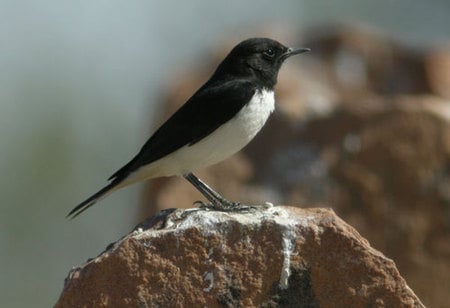 During the course of these next few days we will move further west out into the Thar Desert in search of some of our key target species. Most notable of these is the Great Indian Bustard, and our visits to the famous Desert National Park give us an unparalleled opportunity to observe these huge birds in their native environment. Indeed, to observe a couple of these very rare birds walking across the desert landscape is something never to be forgotten. We will also search for the rare and extremely localised Stoliczka's or White-browed Bushchat which can only be found in and around the Thar Desert. Whilst searching for these two enigmatic species, there will be large flocks of mainly Chestnut-bellied Sandgrouse flying overhead to watering holes further out in the desert, and sometimes we can see Black-bellied or Spotted Sandgrouse as well. Around the entrance gate to Desert National Park Variable Wheatears are perched on every post, Black-crowned Sparrow-larks visit a dripping tap, and are sometimes joined by Desert Larks. Raptors are again very prominent here and we should see good numbers of Tawny Eagles, Long-legged Buzzard and Laggar Falcons patrolling the area or perched on top of bushes or telegraph posts. Further forays by 4-wheel drive into areas outside the park could reveal Bonelli's Eagle, small groups of Cream-coloured Coursers, Isabelline and Desert Wheatears, Greater Hoopoe Lark, Bimaculated Lark, Graceful Prinia, Sykes's Warbler, Eastern Orphean Warbler, Desert Whitethroat, Punjab Raven, and sometimes Plain Leaf-warbler. Another productive site holds Asian Desert Warbler and Trumpeter Finch, whilst a nearby lake can produce some strange sightings out here in the desert, most notably a Small Pratincole on our recce visit. We will spend 3 nights at the wonderful Hotel Himmatgarh Palace in Jaisalmer and one night at the Rajasthan Desert Safari Camp, which is nestled between the very attractive sand dunes of Sam and will give us a real insight into desert life from the comfort of our en-suite, deluxe walk-in tents! There will be a little downtime on our first morning, when our permits to visit Desert NP are being processed and there will be a chance of some sightseeing around the beautiful desert town of Jaisalmer.
During the course of these next few days we will move further west out into the Thar Desert in search of some of our key target species. Most notable of these is the Great Indian Bustard, and our visits to the famous Desert National Park give us an unparalleled opportunity to observe these huge birds in their native environment. Indeed, to observe a couple of these very rare birds walking across the desert landscape is something never to be forgotten. We will also search for the rare and extremely localised Stoliczka's or White-browed Bushchat which can only be found in and around the Thar Desert. Whilst searching for these two enigmatic species, there will be large flocks of mainly Chestnut-bellied Sandgrouse flying overhead to watering holes further out in the desert, and sometimes we can see Black-bellied or Spotted Sandgrouse as well. Around the entrance gate to Desert National Park Variable Wheatears are perched on every post, Black-crowned Sparrow-larks visit a dripping tap, and are sometimes joined by Desert Larks. Raptors are again very prominent here and we should see good numbers of Tawny Eagles, Long-legged Buzzard and Laggar Falcons patrolling the area or perched on top of bushes or telegraph posts. Further forays by 4-wheel drive into areas outside the park could reveal Bonelli's Eagle, small groups of Cream-coloured Coursers, Isabelline and Desert Wheatears, Greater Hoopoe Lark, Bimaculated Lark, Graceful Prinia, Sykes's Warbler, Eastern Orphean Warbler, Desert Whitethroat, Punjab Raven, and sometimes Plain Leaf-warbler. Another productive site holds Asian Desert Warbler and Trumpeter Finch, whilst a nearby lake can produce some strange sightings out here in the desert, most notably a Small Pratincole on our recce visit. We will spend 3 nights at the wonderful Hotel Himmatgarh Palace in Jaisalmer and one night at the Rajasthan Desert Safari Camp, which is nestled between the very attractive sand dunes of Sam and will give us a real insight into desert life from the comfort of our en-suite, deluxe walk-in tents! There will be a little downtime on our first morning, when our permits to visit Desert NP are being processed and there will be a chance of some sightseeing around the beautiful desert town of Jaisalmer.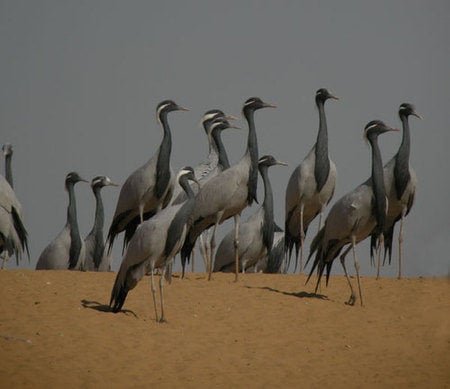 Today we will visit one of the least known but most spectacular avian gatherings on the planet when we make the pilgrimage to the small village of Khichan. During the winter months up to 6,000 Demoiselle Cranes take up residence around the village and nearby sand dunes where they seemingly live in harmony with the villagers. For as long as anyone can remember the villagers have fed these birds and we can watch from the rooftops and at quite close range as thousands of these graceful birds descend to feed on the grain put out for them. It is quite simply an unbelievable spectacle and to witness the sheer volume of birds and hear the noise of their wings and bugling when they come into feed and fly close by is an amazing experience. By visiting here and making donations to help the villagers buy grain we will be doing our own small part to help conserve this tradition. After the many photographic opportunities are over we will head for Jodhpur, passing through the dry, desert scrub where there are further chances to catch up with any species still missing from our lists. Night Jodhpur.
Today we will visit one of the least known but most spectacular avian gatherings on the planet when we make the pilgrimage to the small village of Khichan. During the winter months up to 6,000 Demoiselle Cranes take up residence around the village and nearby sand dunes where they seemingly live in harmony with the villagers. For as long as anyone can remember the villagers have fed these birds and we can watch from the rooftops and at quite close range as thousands of these graceful birds descend to feed on the grain put out for them. It is quite simply an unbelievable spectacle and to witness the sheer volume of birds and hear the noise of their wings and bugling when they come into feed and fly close by is an amazing experience. By visiting here and making donations to help the villagers buy grain we will be doing our own small part to help conserve this tradition. After the many photographic opportunities are over we will head for Jodhpur, passing through the dry, desert scrub where there are further chances to catch up with any species still missing from our lists. Night Jodhpur. 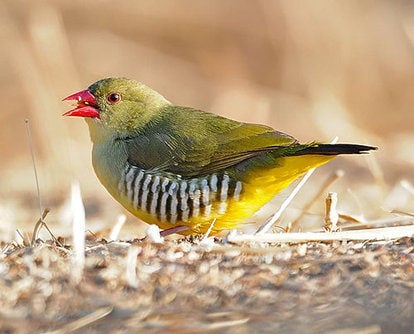 After breakfast we will set out on the drive to Mount Abu, a seldom visited site by western birders but which is home to a remarkable variety of sought-after birds. Most highly prized of these is the rare and enigmatic Green Avadavat and this is one of very few places in all India where it has been seen at all! We have a very good chance of finding this highly desirable species plus a strange mixture of other key species. In particular we will look for 3 Indian endemics, Red Spurfowl, Grey Junglefowl and Indian Scimitar-babbler which inhabit this hill station set below a peak of 1720m in the Aravalli Hills. Commoner birds present include Alexandrine and Plum-headed Parakeets, Black-rumped Flameback, Tickell's Blue, Red-breasted and Verditer Flycatchers, Sulphur-bellied Warbler, Tawny-bellied and Yellow-eyed Babblers, White-bellied and Ashy Drongos, Common Rosefinch, Crested and White-capped Buntings. Night at Mount Abu.
After breakfast we will set out on the drive to Mount Abu, a seldom visited site by western birders but which is home to a remarkable variety of sought-after birds. Most highly prized of these is the rare and enigmatic Green Avadavat and this is one of very few places in all India where it has been seen at all! We have a very good chance of finding this highly desirable species plus a strange mixture of other key species. In particular we will look for 3 Indian endemics, Red Spurfowl, Grey Junglefowl and Indian Scimitar-babbler which inhabit this hill station set below a peak of 1720m in the Aravalli Hills. Commoner birds present include Alexandrine and Plum-headed Parakeets, Black-rumped Flameback, Tickell's Blue, Red-breasted and Verditer Flycatchers, Sulphur-bellied Warbler, Tawny-bellied and Yellow-eyed Babblers, White-bellied and Ashy Drongos, Common Rosefinch, Crested and White-capped Buntings. Night at Mount Abu.Single supplement: £325.00 Deposit: £350.00
Group size: Minimum for tour to go ahead 5 and maximum 10 with 2 leaders.
Included in cost: Accommodation in twin rooms en-suite except at Tal Chhapar where facilities are shared, all meals except in Delhi, bottled water, all entrance fees, train tickets, all surface transport throughout, jeep safaris and services of leaders.
Not included: International flight, insurance, meals in Delhi, drinks, tips, and items of a personal nature.
Flight information: If travelling from the U.K please note that you need to arrive in Delhi by midday on Day 1 in order to take part in the excursion to Okhla Barrage. Departure should be from Delhi either in the late evening of Day 12 or early the following morning. Please contact our agent Shane Wheatley at Dial-a-Flight on 01732 591470 or 01732 593196 for the best up to date flights that you can book for your requirements.
Accommodation: Varies from very good with full en-suite facilities at most places to relatively basic at Tal Chhapar. We endeavour to stay in the very best accommodation available closest to the birding sites.
Tour Code: This is a standard birding tour with regular birding walks along roads and well marked trails. Some long drives are necessary. As we are spending most of our time birding in the desert regions of western Rajasthan we can expect the weather to be hot during the day, but overnight, dawn and dusk to be chilly. There is very little chance of rain throughout the tour.
This tour can be combined with our Gujarat tour creating a very thorough coverage of western India, plus the attraction of seeing the recently discovered Forest Owlet.
Receive our e-newsletter:
Join the Zoothera e-mailing list for up-to-date news on new tours, tour reports and special offers.
e-mail [email protected] to sign up.
View Tour itinerary as a PDF file
